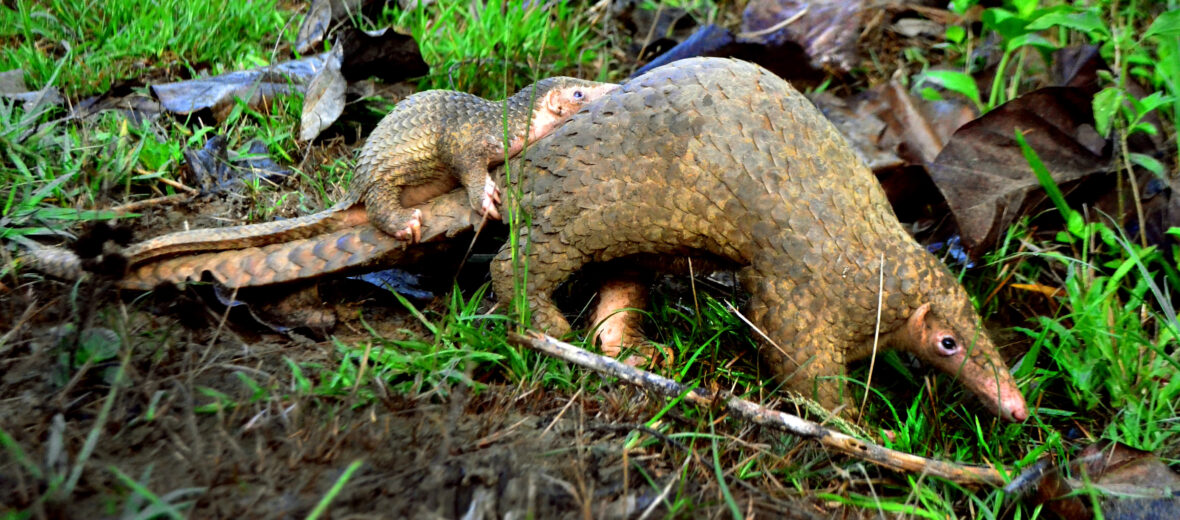
The Philippine pangolin, aka balintong or Palawan pangolin, hails only from the Palawan province of the Philippines. They prefer primary and secondary forests, nearby grasslands, and often frequent agricultural areas. Sadly, due to habitat loss and destruction at the hands of the logging industry; ecosystem modifications; hunting; and trapping, these amazing creatures are listed as Critically Endangered by the IUCN. Their numbers are also decreasing.
First the Stats…
Scientific name: Manis culionensis
Weight: Up to 77 lbs.
Length: Up to 35 inches, plus up to a 35 inch tail
Lifespan: Up to 20 years
Now on to the Facts!
1.) The Palawan Council for Sustainable Development (PCSD) also lists these critters as Critically Endangered.
2.) These pangolins are related to but different from Sunda pangolins in that they are smaller, with a smaller head, and smaller scales.
3.) Philippine pangolins are nocturnal (active at night).
4.) They are typically witnessed alone or in pairs.
5.) These critters have poor eyesight and hearing, but have an amazing sense of smell.
But wait, there’s more on the Philippine pangolin!
6.) The Philippine pangolin typically moves about slowly but can run at speeds of up to 3.10 mph.
7.) When walking, they do so on all fours, curling in their forelimbs to protect their sharp claws. When running, they will stand on their hind legs and use their tail for balance.
Did you know…?
Female Philippine pangolins will sometimes even adopt orphaned pangopups, suckling and raising them as her own.
8.) While typically arboreal (spend their lives in trees) they do travel to the ground to forage, once in a while.
9.) When threatened, they will produce a stinky musk, like that of a skunk, and coil into a tight ball; relying on their tough scales to protect themselves.
10.) Although not overly territorial, they will mark the places they’ve been with a strong musk scent.
But wait, there’s still more on the Philippine pangolin!
11.) Even though they are primarily myrmecophages (eat ants), they will also feast on termites, other insects, and other invertebrates.
12.) During the breeding season, males will utilize their stinky musk to ward off other males. The female also musks around her nest while tending to her pangopup.
Did you know…?
Like all pangolins, they are hunted for their scales, meat, and organs. The meat is considered a delicacy and their scales and organs are utilized in traditional medicine, which has been proven not to cure anything at all.
13.) Females undergo up to an 18 week gestation (pregnancy) that yields a single pangopup.
14.) As the pangopup matures, it will hitch a ride on mom’s tail and back till about 5 month’s time.
15.) For protection of herself and her young, the mother will coil into a ball around her pangopup. Her offspring will also coil into a ball.
But wait, there’s still little more on the Philippine pangolin!
16.) Philippine pangolins are important animals in that they fill an ecological niche due to their control of ants and termites.
17.) The common name balintong, halintong, and malintong translates to “one who somersaults” or “one who rolls over,” and is from the Visayan Cuyonon language.
Did you know…?
The sharp scales on their tail are sometimes used in self-defense and are utilized to poke an attacker.
18.) Other common names are balekon, balikon, tanggiling, tangiling, or goling, which hails from the Palawan language.
19.) Their sharp claws are not used as a defense, but rather for digging out ant hills and termite mounds.
20.) These critters are able to stand for long periods of time on their hind legs, using their tail as a balance.
But wait, there’s still tad more on the Philippine pangolin!
21.) If necessary, these critters are capable of swimming too.
22.) Their tongue is up to 10 inches long and coated with sticky saliva.
23.) The entire ant hill or termite mound is not destroyed. These critters are sustainable hunters in that they leave a portion of the hill or mound behind to allow their food source to continue to grow. This provides a sustainable food source for the long haul.
24.) Sand and small stones are also ingested to aid in grinding up their chitinous (tough to eat) prey. These are called gastroliths.
25.) Natural predators of these pangolins are leopards and pythons.
Now a Short Philippine Pangolin Video!
Be sure to share & comment below! Also, check out the Critter Science YouTube channel. Videos added regularly!
Want to suggest a critter for me to write about? Let me know here.
Some source material acquired from: Wikipedia & IUCN
Photo credit: Shukran888



